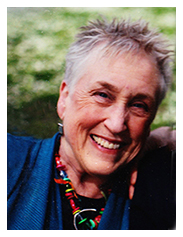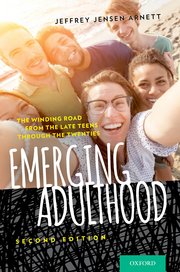Vicky Kelman
 Emerging Adulthood: The Winding Road from the Late Teens Through the Twenties by Jeffrey Jensen Arnett
Emerging Adulthood: The Winding Road from the Late Teens Through the Twenties by Jeffrey Jensen Arnett
I don’t know if we actually need this book to tell us that there is a life cycle stage between adolescence and adulthood. After all, we see it right before our eyes in our homes, families and workplaces. But while we might be wondering what phenomenon we are seeing, Jeffrey Arnett provides us with a label, “emerging adults,” and a definition, and we say, “Ah, yes. Of course. That’s what it is! I recognize that phenomenon. Why hasn’t anyone provided this helpful label before?”
“Longer and more widespread education, later entry into marriage and parenthood and a prolonged and erratic transition to stable work have opened up a space for a new life stage in between adolescence and young adulthood, and “emerging adulthood” is what I have proposed to call that life stage.” (chapter 1)
Arnett defines this stage as stretching from 18 (end of high school) until 25 (with the upper age boundary flexible, 29 being the absolute end [although we probably all know people who took even longer]).
We know these “emerging adults.” They are our kids and our nieces and nephews. They are our youth leaders, Jewish community interns and (sometimes) staff, camp counselors, bar/ bat mitzvah tutors and synagogue school teachers.
The label and profile that Arnett provides can turn out to be helpful as we continue to engage with our emerging adults and with their families. Arnett helps us see our 18-25 year olds as moving on and sorting out the elements that make for an adult life (rather than stigmatizing them as immature or failing to grow up). I think his take on this age group can help us understand some of the baffling (to us) behaviors we see.
“ Emerging adults know that are supposed to have a Plan with a capital “P,” that is, some kind of idea about the route they will be taking from adolescence to adulthood, and most of them come up with one. However, for most of them, their Plan is subject to numerous revisions during the emerging adult years.” (ch. 1)
The themes of this stage, as Arnett lays them out, at the start of his book, could also be seen as the tasks of this stage:
Identity exploration
- Instability
- Self-focus
- Feeling in-between
- A sense of wide open possibilities
The challenge of this perspective for us, is to re-frame our view of and interactions with the emerging adults we encounter so that we can see in the changing majors, changing jobs, changing geographic base, serial intimate relationships, and self-immersion as ultimately in the service of moving them forward in the right direction (rather than seeing them as failing to face the future). We need to be able to see these as positives in that emerging adults are doing what they need to do, in the world as it is right now, to move ahead. (It may not look at all like your post-college life but it is theirs.)
This leaves two big questions:
-
What does it mean to be an “adult? ”
Traditionally the answer to that has been: marriage But marriage is no longer that signifier in American society. For most emerging adults today, marriage is no longer that threshold step into adulthood. Many have lived on their own for a while, may have lived with their partner prior to marriage, certainly lived outside their family home, experienced sexual intimacy. Marriage, though a significant step, does not represent attaining the status of adulthood. In fact, in research done around this question, marriage is near the bottom in a ranking of what people think defines an adult.
Parenthood? Also seems to hold a very low ranking (along with marriage) in surveys assessing what people think determines adult status.
If not marriage or parenthood, then what? Arnett’s wide-ranging research turns up this answer, almost unanimously: “becoming an adult today means becoming self-sufficient, learning to stand alone as an independent person.” (ch 13)
And the kind of self-sufficiency required for adulthood, has these three hallmarks:
- Taking responsibility for yourself
- Making independent decisions
- Being financially independent
There is no longer a clear cut bright line with a banner proclaiming the finish line when someone leaves adolescence and emerging adulthood behind and has crossed into adult territory, as previous generations and other cultures had marriage or parenthood. Self-sufficiency is more gradual and less obvious…but it is recognizable and emerging adults can identify when they feel they are there.
-
How do we as parents, teachers, mentors help to guide our adolescents and emerging adults so that they actually reach adulthood?
Of course, this journey starts out in childhood. The tasks to be mastered to be a self-sufficient person, are not something to be grappled with suddenly in the emerging adult phase. The seeds have to be planted way before that.
Seen through Jewish parenting eyes, a famous section from the Babylonian Talmud seems to tell us what we need to know with regard to this: “The obligations of a father [parent] to a son [child] are: to circumcise him, to redeem him, to teach him [her] Torah; to marry him [her] off; to teach him [her] a trade; and some say to teach him [her] to swim.” (Babylonian Talmud, Kiddushin 29a)
- Circumcision represents the decision to bring a child into the covenant, meaning intentionally bringing him/her into the circle of the Jewish community and live a life that is based there
- Pidyon ha-Ben represents the custom of buying back the first child from predetermined service in the priesthood; for us it might represent setting our first borns free from a predetermined path and allowing them to choose their own way in the world in which to serve God
- Teach Torah stands for to provide a solid Jewish education
- marry him/her off indicates the goal of helping children grow in a way that encourages building friendships, care about others, love and ability to commit to and trust another person
- teach him/her a trade represents the responsibility to see that our children get a well-rounded education, find something they love to do, learn to do something useful in the world, contribute to society and support themselves and their families
- And some say: Teach them to swim is usually taken to mean teach them to swim in the world, “street smarts,” the ability to problem-solve, make good choices and take care of themselves out in the world, what Wendy Mogel calls, “self-knowledge and risk-management skills” (Blessing of a B-, p. 160)
This text from the Talmud almost provides a parenting-how-to for those of us who as parents, teachers, aunts and uncles, grandparents and mentors, need to take the long view of the children we spend time with. These are the tasks we need to accomplish if we are to help our children and those entrusted to our care, to complete their tasks, to become adult (way down the line).
The skillful execution of these parenting tasks can lead to the self-sufficiency described by Arnett’s informants as the hallmark of adulthood.
A crucial chapter for those of us invested in the Jewish community and its future, Arnett’s chapter 9, Sources of Meaning: Religious Beliefs and Values, is a cornerstone for understanding this aspect of the emerging adult’s life. Making sense of the world is a important plank in the enterprise of identity- building. “It is during emerging adulthood that people address world-view questions most directly, and it is during emerging adulthood that most people reach at least an initial resolution to their worldview questions.” (ch. 9)
Again, what he sees and documents through research are all phenomena that we have seen and know well. We see the “common determination to think for themselves with regard to religious issues” (ch 9) Arnett brings clarity to that search by linking it to the core of his book, the tasks along the journey to adulthood. The leave-of-absence from Jewish life phenomenon, often a source of weeping and wailing in the Jewish community, is not a step off the path, but a step forward along it.
I think that the questions he asks in this realm (and the questions asked in the research he relies on) provide fruitful starting places for conversations we might have about the meaning of life (which include “religion”) with the emerging adults in our lives. They will provide launching points for the kind of meaningful conversations that can be illuminating for us and fruitful for them. Try it.
Read this book, and pay special attention to chapter 9.


